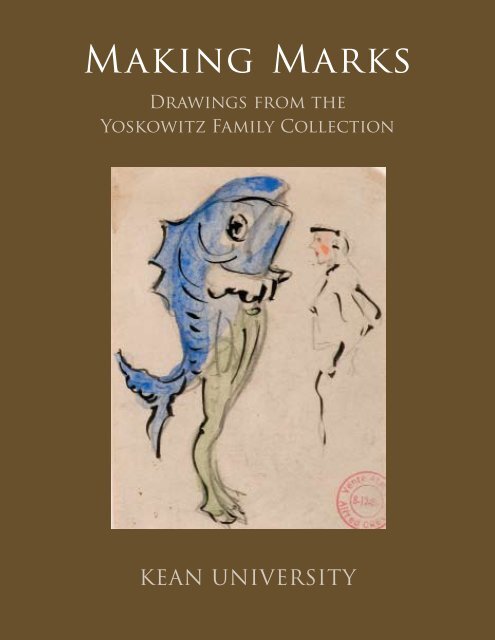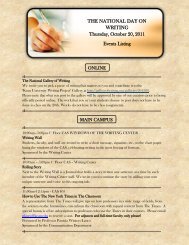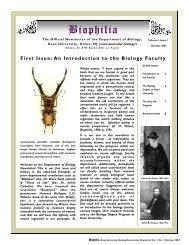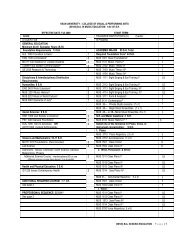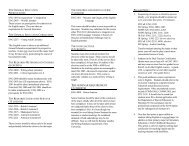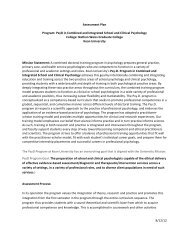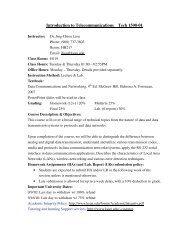Making Marks - Kean University
Making Marks - Kean University
Making Marks - Kean University
- TAGS
- marks
- kean
- university
- www.kean.edu
Create successful ePaper yourself
Turn your PDF publications into a flip-book with our unique Google optimized e-Paper software.
<strong>Making</strong> <strong>Marks</strong><br />
Drawings from the<br />
Yoskowitz Family Collection<br />
<strong>Kean</strong> UniversitY
For Cathy and Molly, who put up with me—and my obsession.<br />
<strong>Making</strong> <strong>Marks</strong>: Drawings from the Yoskowitz Family Collection<br />
Published by <strong>Kean</strong> <strong>University</strong>, Karl and Helen Burger Gallery, 1000 Morris Avenue, Union, New Jersey 07083<br />
www.kean.edu/~gallery<br />
Copyright © 2010 by <strong>Kean</strong> <strong>University</strong>, Union, New Jersey<br />
Essays and photographs: copyright © 2010 by individual authors. All rights reserved.<br />
No part of this book may be reproduced in any form including electronic or mechanical<br />
means, photocopying, and information storage and retrieval systems, except in the case<br />
of brief extracts for the purpose of critical articles and reviews, without permission in<br />
writing from <strong>Kean</strong> <strong>University</strong>.<br />
ISBN 978-1-61658-910-3<br />
Photographs • Richard Russo<br />
Catalogue Design and Production<br />
Paul Klonowski • paul@mindsetcs.com<br />
Curator • Neil Tetkowski, Director of <strong>University</strong> Galleries<br />
Cover:<br />
Alfred Grevin (French, 1827–1892)<br />
Study for Costume, 1880s<br />
Graphite, ink, and watercolor on paper, 4¾ x 3½ in.<br />
Grevin’s illustrations and paintings were mostly for and about the theater. This study features a proto-Surrealist<br />
image of an individual wearing a fish costume and conversing with someone who appears to be the stage manager.
<strong>Making</strong> <strong>Marks</strong><br />
Drawings from the<br />
Yoskowitz Family Collection<br />
January 28–March 12, 2010<br />
Karl and Helen Burger Gallery<br />
The Maxine and Jack Lane Center for Academic Success<br />
KeAn UniverSiTy
Robert Laurent (American, born France, 1890 –1970)<br />
Portrait of a Woman, 1920s. Graphite on paper, 11¼ x 7 in.<br />
Laurent, a sculptor, was a prodigy of Hamilton Field and with him set up an artist’s colony in Ogunquit,<br />
Maine, during the 1920s. Laurent was greatly drawn to the abstract and flat aspects of American folk art.
Introduction<br />
In the early 1970s, a bright young student at <strong>Kean</strong> College, Robert Yoskowitz, majored in painting<br />
and graduated with a bachelor’s degree in fine art. He immediately went on to pursue his interests in<br />
studio, history, and philosophy of art and over the next twenty years would earn three advanced degrees<br />
and become a college professor. All during that time, he collected works of art, sharpened his eye, and<br />
honed his passion for art. Equipped with only modest means but an extraordinary wit, Yoskowitz has<br />
collected at every stage of life. As a young boy, he accumulated coins, stamps, and military patches,<br />
and as he got older, his interests and opportunities broadened and he collected photography, American<br />
folk art, ceramics, and drawings.<br />
The current exhibition, <strong>Making</strong> <strong>Marks</strong>: Drawings from the Yoskowitz Family Collection, is featured at<br />
<strong>Kean</strong> <strong>University</strong>’s Karl and Helen Burger Gallery from January 28 through March 12, 2010. The fifty-one<br />
original drawings in the show were made using traditional techniques and materials, such as graphite,<br />
pen and ink, brush and ink, chalk, and Conté crayon, on a variety of paper surfaces. The artists come<br />
from Western Europe and the United States, and all can be loosely associated with Modernism, the term<br />
used to describe the style and theory of art that came into its own from the late nineteenth century into<br />
the mid-twentieth century.<br />
Modernist artists such as those in this exhibition are characterized by freely expressed creativity and<br />
a departure from literal representation. As photography became increasingly popular in the 1850s, the<br />
realistic approach to painting and sculpture was considered by many to be unnecessary and irrelevant<br />
to modern life. Progressive philosophers and artists began searching for new ways of responding to and<br />
thinking about nature and the function of art in society. They embraced the freedom of expression in the<br />
belief that art should stem from color, form, mood, and gesture rather than from an accurate rendering<br />
of the natural world. The artists in this exhibition represent this new way of depicting life, ushering in the<br />
modern age.<br />
On behalf of <strong>Kean</strong> <strong>University</strong>, I want to thank Robert and Catherine Yoskowitz for their efforts in<br />
planning and lending all the works being shown in this exhibition. For the installation, we are grateful<br />
to our graduate assistants Samantha Jackson and Kelly Murphy. Special thanks go to <strong>Kean</strong> <strong>University</strong><br />
President Dawood Farahi, Vice President Mark Lender, and Holly Logue, Acting Dean of the College of<br />
Visual and Performing Arts. We appreciate their support for the growing exhibition program and the<br />
opportunity to show this wonderful drawing exhibition.<br />
Neil Tetkowski<br />
Director of <strong>University</strong> Galleries<br />
3
Gary Stephan (American, born 1942)<br />
Study for a Painting, 1980. Gouache and graphite on clay-coated paper, 13 1 /2 x 9 5 /8 in.<br />
This sheet is a visual exercise in the figure/ground relationship. A torso shape in black clings to a scaffolding<br />
grid that supports the torso; instead of being read in volumes, however, the shape is curiously left flattened.<br />
4
A Collecting Obsession<br />
One is a thing. Two are a pair. Three or more are a collection.<br />
When I was a child, my father brought home bags of coins from the vending machines he worked<br />
on and let me pick out the pennies that I needed to fill my Blue Books. My grandfather brought me<br />
stamps, which I pasted into albums. Eventually, I became an active collector, mail-ordering franked<br />
foreign postage in bulk to fill up other albums; it was always a special day when a thick manila envelope<br />
arrived with my name on it.<br />
The same went for military patches. I was not all that enthralled with the armed forces, but, as with<br />
the stamps, I was fascinated by the colors, shapes, and patterned surfaces of the patches. A budding<br />
formalist at such a tender age!<br />
When I began my undergraduate work at what is now <strong>Kean</strong> <strong>University</strong>, I often traveled into New York<br />
City, where I picked up cards and posters at art exhibitions I visited. I used them to decorate my dorm<br />
room with an assortment of images, from Pop Art to Minimalism and Conceptualism.<br />
As a sophomore, I purchased my first “real” work of art, a Jim Dine offset lithograph signed on the<br />
plate and countersigned in pencil, all for twenty dollars (in those days, twenty dollars represented the<br />
sacrifice of at least two weekend movie-and-dinner dates). In my junior year, I was impressed by an<br />
exhibition, at the Vaughn Eames Gallery, of Mannerist and Baroque drawings from the collection of<br />
Professor Thomas Wilbur of the Fine Arts Department at <strong>Kean</strong> <strong>University</strong>.<br />
In the years after I graduated, these experiences morphed into an interest in collecting photography,<br />
a pursuit that was possible in the 1970s for someone of modest means. I discovered that my wife and<br />
I could display original works by well-known artists in our home for a surprisingly small sum.<br />
I soon acquired a portrait of Willem de Kooning by Rudy Burckhardt and a color image by Stephen<br />
Shore. By the 1980s, my interest in collecting had grown in many directions, from George Ohr pottery<br />
to folk art to drawings, a range of genres that received more or less equal attention.<br />
The collection has continued to take shape over the past thirty years. In general, my criteria for adding<br />
a work to the collection have included: high quality of execution, the unique expression of a period<br />
in art history, and the opportunity to learn more about the work or the artist—all tempered by the limits<br />
of my budget.<br />
My collection of drawings is not based on a slavish adherence to any particular theory or philosophy<br />
of art but has been shaped by my emotional connection to individual works, a connection that I feel long<br />
before I am able to articulate it. Only after this initial intimate contact can I begin to appreciate a work’s<br />
intellectual importance as a link in the historical chain of Modernism.<br />
That said, why did I gravitate to Modernism instead of other periods? What made me want to comprehend<br />
its intrinsic visual power? Modernism and its variety of styles tell the story of human experience from the<br />
late nineteenth through the twentieth century. Avant-garde artists reveled in the confluence of industrial<br />
and technological progress with an expanded understanding of the human mind, and they set to work<br />
5
creating l’art pour l’art—art for art’s sake. For the first time in recorded history, artists were free of the<br />
dictates of church, patron, and state.<br />
The Modernist period was characterized by an absence of narrative and a tendency toward flatness<br />
on the picture plane, a rejection of Renaissance linear perspective in favor of a Cubist re-orientation of<br />
space, the inventive use of color in Fauvism, the psychological positioning of dreams in Surrealism, the<br />
inner state of the mind achieved in Abstract Expressionism, and the power of contemporary imagery<br />
in Pop Art. By the last quarter of the twentieth century, Minimalism had distilled the critical aspects of<br />
Modernism into its purest forms.<br />
A significant factor contributing to what we now call modern art was the cultural and intellectual<br />
climate—the zeitgeist—of the period from 1880 to 1910 in Western society, when the ideas of such<br />
intellectuals as Henri Bergson, Sigmund Freud, and Albert Einstein, coupled with the evolution of<br />
technology, led to unprecedented social change. One can compare that transformational cacophony<br />
in both art and life to what is happening now in our digital age.<br />
My collection of Modernist drawings is not by any means encyclopedic but is the result of individual<br />
works having caught my interest because of their execution or their particular back stories. For example,<br />
I especially admire the immediacy of Fauvist drawings, which came about as artists wandered the<br />
streets with ink and brush and jotted down their impressions quickly without editing. Artists in the coterie<br />
of Henri Matisse, such as Albert Marquet, Charles Camion, Emile-Othon Friesz, and Henri Manguin,<br />
evoked modern life by expressing their everyday experience on paper.<br />
What is that everyday experience? For those artists, it was not art drawn from mythology, religion,<br />
or history; it was not based on a narrative or iconography. Their subject was the here and now, modern<br />
life as these artists were living it.<br />
What excites me most about the drawings in this exhibition is the story behind the marks on the<br />
surface. A drawing expresses an artist’s initial idea; the execution of every line leads to a finished work<br />
that will take its place in the context of the history of art. It is that immediacy, that basic expression<br />
of creativity, which hits me every time, whether the medium is graphite, pen and ink, brush and ink,<br />
chalk, or Conté crayon on a variety of paper surfaces.<br />
In selecting works for this exhibition, I have relied on my training and experience as an artist and art<br />
historian, as well as my emotional response to the unique qualities of each work. The drawings are often<br />
small, encouraging a tête-à-tête that puts the viewer in a personal relationship with the artist at work.<br />
It enlivens me to look at an artist’s marks on a sheet and know they represent a unique moment in art,<br />
when an inspiration begins to take shape on its way to becoming a completed work, one that may open<br />
my eyes to a new way of seeing the world.<br />
Some of the drawings here were chosen to represent a period in art history because they offer up<br />
contextual evidence of their time and place. For example, the crisp, mechanical line of Stephan Hirsch’s<br />
drawing from the Precisionist period of the 1920s leaves the imprint of a figure, one that is clearly<br />
American, cool, and industrial. By contrast, Carlo Carra’s figure is a “mechanomorph,” simultaneously<br />
6
dreamlike and industrial, reflecting the Scuola Metafisica of the Italian 1920s. Simply put, modernity<br />
fascinates me because it tells us where we have been and where we are going.<br />
It goes without saying that I hope this exhibition will spur interest in collecting works of art. As Professor<br />
Wilbur demonstrated to me many years ago, it is possible to build a gratifying collection of art these<br />
days, even on a professor’s salary. Research and passion, patience and time are what make collecting<br />
a satisfying experience—and a splendid lifelong pursuit.<br />
Robert W. Yoskowitz graduated from <strong>Kean</strong> College in 1973. He holds advanced degrees from Pratt Institute, Hunter<br />
College, and City <strong>University</strong> of New York, in New York City. He is a senior professor of fine art at Union County College<br />
in Cranford, New Jersey. Robert Yoskowitz lives with his wife, Catherine, and daughter, Molly, in Whitehouse Station,<br />
New Jersey.<br />
Henry Glintenkamp (American, 1887–1946)<br />
Woman on Bed, 1916<br />
Conté crayon on paper, 4¾ x 8 in.<br />
Early in his career, Glintenkamp (a native of New Jersey) was associated with the communalist cause<br />
and produced illustrations for The Masses, a socialist publication. In this drawing, a woman, who has<br />
fallen asleep after reading, has turned her back to us, making the viewer feel like a voyeur. Interestingly,<br />
the artist’s energetic line is at odds with what would otherwise be a tranquil scene.<br />
7
Émile-Othon Friesz (French, 1879 –1949)<br />
Scène d’Orientalist, ca. 1907<br />
Ink on paper, 5¾ x 8¾ in.<br />
A friend of Braque, Pissarro, and Matisse, Friesz exhibited in the first Salon d’ Automne in 1904 and in<br />
the Salon des Indépendants in 1906. Also influenced by the Fauve painter Albert Marquet, Friesz here<br />
reflects the immediacy of Marquet’s work by laying down ink in a dry brush technique with swift, sure<br />
strokes. The viewer can only wonder if this is the same Bedouin figure repeated or multiple figures<br />
viewed from different vantage points suspended on an empty plane.<br />
Opposite:<br />
Abraham Walkowitz (American, born Russia, 1878–1965)<br />
Worker, ca. 1907<br />
Charcoal on paper, 12¼ x 7¾ in.<br />
Walkowitz was an early associate of Alfred Stieglitz and his Little Galleries of the Photo-Secession at<br />
291 Fifth Avenue. Best known for his abstracted views of New York City and his numerous studies of<br />
the modern dancer Isadora Duncan, Walkowitz was influenced by Cézanne, like many other avant-garde<br />
artists in the United States. This drawing of a worker reflects his knowledge of Cézanne’s artwork, especially<br />
his Bathers series.<br />
9
10<br />
Roger de la Fresnaye (French, 1885–1925)<br />
Study for “Italian Girl,” 1911<br />
Ink on paper, 13 x 9¾ in.<br />
This is an initial sketch for a painting and a sculpture of the<br />
same name that the artist completed in 1912. De la Fresnaye<br />
was associated with the Cubist group that called itself the<br />
Section d’Or and exhibited with them from 1912 to 1914.<br />
The face of the woman in this drawing has a tribal quality,<br />
and the body is loosely rendered with a modicum of shading.<br />
In the upper right of this sheet are two mask studies.<br />
Louis Eilshemius (American, 1864–1941)<br />
Just What..., ca. 1920<br />
Ink on stationery paper, 11 x 8½ in.<br />
An idiosyncratic artist, Eilshemius began as a disciple of the<br />
Barbizon painter Camille Corot, but by the turn of the twentieth<br />
century, his figurative work had become increasingly distorted<br />
and surreal, bordering on kitsch. Eilshemius held himself in the<br />
highest regard as an artist, while Marcel Duchamp and Joseph<br />
Stella championed his cause as well. This drawing conveys<br />
Eilshemius’s frustration with his lack of recognition and his<br />
dislike of abstraction.<br />
Charles Camoin (French, 1879–1965)<br />
Feathered Landscape, ca. 1905<br />
Ink on paper, 5¼ x 8½ in.<br />
Camoin met Matisse at Gustave Moreau’s studio and exhibited<br />
with the Fauves in the infamous Salon d’Automne of 1905.<br />
Camoin was also a friend of Cézanne’s.
Oscar Bluemner (American, born Germany, 1867–1938)<br />
Silver Lake, North Canal Shed, 1918<br />
Colored pencil on paper, 5 x 6 1/8 in.<br />
Bluemner emigrated from Germany and settled in Bloomfield, New Jersey, where he lived from 1916 to 1923.<br />
This small colored drawing is one of many studies he made there. Trained as an architect, Bluemner became<br />
an artist in search of the spiritual in art, with a special interest in landscape painting. He had a solo exhibition<br />
at Stieglitz’s 291 Gallery in 1915.<br />
11
12<br />
William Baziotes (American, 1912–1963)<br />
Untitled, ca. 1952<br />
Ink on paper, 11 x 8½ in.<br />
Baziotes was a member of the so-called Irascibles, a group<br />
of American abstract painters who wrote a letter of protest in<br />
1950 to the Metropolitan Museum of Art, which they felt was<br />
antagonistic to avant-garde American art movements such as<br />
Abstract Expressionism. The group, which included Abstract<br />
Expressionist masters Jackson Pollock, Willem de Kooning,<br />
and Mark Rothko, was influenced by many different ideas.<br />
Here Baziotes is referencing his interest in the primordial,<br />
inspired by visits to the American Museum of Natural History.<br />
Jules Pascin (American, born Bulgaria, 1885–1930)<br />
Le Repas de Famille, ca. 1915<br />
Ink on board, 12 x 16 in.<br />
A number of eastern European artists in Paris shared studio<br />
space at La Ruche (the Beehive), an artists’ residence<br />
named for its unusual shape. Pascin’s cronies at the studio<br />
were Amedeo Modigliani and Chaim Soutine. Several other<br />
important figures occupy the space in this drawing: at the far<br />
left, seated with his girlfriend Madeleine Pagès, is Guillaume<br />
Apollinaire, a writer and critic who was a champion of Cubism,<br />
especially of Pablo Picasso. The bearded painter is the<br />
Mexican artist Diego Rivera; also seated is André Salmon,<br />
another Cubist critic, and the bespectacled author André Billy.<br />
Jules Pascin (American, born Bulgaria, 1885–1930)<br />
Brothel Scene, 1927<br />
Graphite on paper, 7½ x 12¾ in.<br />
In the long tradition of brothel paintings one may include works<br />
by Edgar Degas, Henri de Toulouse-Lautrec, and Pablo Picasso,<br />
whose breakthrough painting was Demoiselles d’Avignon of<br />
1907. Pascin’s women, who are depicted lounging as they await<br />
their clientele, are enhanced by the use of a soft pencil; they<br />
float in space, as in a reverie (one of those clients has been<br />
scribbled over in the upper center).
Charles Burchfield (American, 1893–1967)<br />
Poplar Study, ca. 1915. Graphite on tan paper, 8¼ x 5 in.<br />
Burchfield was known as a Pantheist for the watercolors he made late in his career in which aspects of<br />
nature were imbued with spiritual meaning. In this early study for a watercolor, Burchfield’s concise line<br />
results in a decorative image of the poplar.<br />
13
Theo van Rysselberghe (Belgian, born France, 1862–1926)<br />
Card Players, 1909<br />
Graphite on chalk on paper, 8¼ x 11½ in.<br />
Van Rysselberghe was a member of Les XX, an avant-garde Belgian group that included James Ensor and<br />
Paul Signac. He adopted the Pointillist technique after seeing La Grande Jatte by Georges Seurat in Paris<br />
in 1886, and his subject matter was often limited to portraits or figurative images. In this drawing, the card<br />
players are softly rendered by his effective use of graphite over chalk.<br />
Opposite:<br />
Jean-Louis Forain (French, 1852–1931)<br />
Exhausted Man, 1890<br />
Graphite on paper, 9 7/8 x 6 1/8 in.<br />
This is a preliminary drawing for an illustration for the French magazine La Vie Parisienne. Forain was much<br />
admired for his caricatures of all levels of French society, especially dancers and their clientele.<br />
14
16<br />
Morgan Russell (American, 1886–1953)<br />
Synchromy Study, 1912<br />
Graphite on paper, 11 3/4 x 8 1/4 in.<br />
Russell, a student of Henri Matisse, created in 1912, with his<br />
American colleague Stanton MacDonald-Wright, the short-lived<br />
style of Synchromism, which was based on the idea that color and<br />
sound are similar phenomena and that the colors in a painting<br />
can be arranged like notes in a work of music.<br />
George Ault (American, 1891–1948)<br />
Landscape, 1922<br />
Graphite on paper, 6 x 8 7/8 in.<br />
The sensuous aspect of this landscape is emphasized by the<br />
electric sky, all rendered within the framework of Precisionism.<br />
George Ault (American, 1891–1948)<br />
Study for “Russell’s Corner,” 1943<br />
Graphite on vellum, 19½ x 9½ in.<br />
This drawing reflects the Precisionist style, one of the predominant<br />
movements of the 1920s and 1930s in America. One of its<br />
attributes was the use of crisp lines to define the edges of objects<br />
(usually machinery, architecture, and so on). Ault painted three<br />
views of the Russell’s Corner, and this drawing relates to all of<br />
them; the tree, garage, and building are all given equal<br />
importance against a plain background.
Otto Gutfreund (Czech, 1889–1927)<br />
Soldier on Crutches, ca. 1916<br />
Ink and graphite, 8 x 5 in.<br />
This Czech sculptor here used Cubism as a scaffold upon which to build his depiction of a wounded soldier<br />
of World War I. Although the soldier’s cap (kepi) and crutch are recognizable, Gutfreund has flattened his<br />
figure, which is conceived in multiple viewpoints, forever maimed in space.<br />
17
Maximillian Luce (French, 1858–1941)<br />
Study for “A Paris Street in 1871,” 1903<br />
Graphite on paper, 8 1/4 x 12 1/4 in.<br />
This sheet shows one of the dying figures that appear in the painting A Paris Street in 1871, which recalls<br />
the Paris Commune three decades earlier. The figure floats in space, ethereal and yet frozen in death.<br />
The pose recalls Édouard Manet’s Dead Toreador of 1863, which was most likely the source for this figure.<br />
Opposite:<br />
Henri Evenepoel (Belgian, 1872–1899)<br />
View of the Street, Paris, ca. 1895<br />
Charcoal on paper, 7 1/2 x 4 7/8 in.<br />
Evenepoel was a friend of Marquet and Matisse, whom he met, along with Georges Rouault, at the atelier<br />
of Gustave Moreau. This drawing gives us an aerial vantage point of modern Paris and is reminiscent of the<br />
urban views of Pissarro and Monet.<br />
19
20<br />
Albert Marquet (French, 1875–1947)<br />
Femme de la Fenêtre, ca. 1905<br />
Ink on paper, 5 7/8 x 3 3/8 in.<br />
A lifelong friend and colleague of Matisse, Marquet created<br />
a multitude of quickly drawn ink sketches as if he were a<br />
camera recording daily experiences. Japanese prints had a<br />
great influence on Marquet, especially in his images of figures<br />
“floating” on the streets of Paris.<br />
Albert Marquet (French, 1875–1947)<br />
Le Chanteur, ca. 1905<br />
Graphite on paper, 6½ x 4 in.
Albert Marquet (French, 1875–1947)<br />
Cheval de Fiacre—Femme en Marche, ca. 1906<br />
Ink on paper, 5 3/8 x 7 3/4 in.<br />
21
22<br />
Henri Edmond Cross (French, 1856–1910)<br />
Femme Debout, ca. 1909<br />
Charcoal on paper, 12 x 9 ¼ in.<br />
Cross anglicized his real surname, Delacroix, so that he would<br />
not be confused with Eugène Delacroix. Cross, who was greatly<br />
influenced by the Pointillism of Georges Seurat and Paul<br />
Signac, evokes the atmosphere of a time and place with marks<br />
in charcoal and pencil. The drawing is delicately diffused and,<br />
like his paintings, achieves a soft, all-over glow. This sheet by<br />
Cross is academic in nature but anticipates the diffused style of<br />
his later drawings.<br />
John Neagle (American, 1796–1865)<br />
Portrait of a Woman, ca. 1830s<br />
Graphite and chalk on dark paper, 8 x 6¼ in.<br />
Neagle is best known for his portraiture. This small, detailed<br />
study indicates the sitter’s status in society through her fine<br />
clothing. He has enhanced her importance by having her<br />
emerge from a dark background, much like a Baroque<br />
portrait of the seventeenth century. Worked in graphite<br />
with white touches, the drawing reveals Neagle’s skill in<br />
expressing light, shadow, and texture.
Arthur Davies (American, 1862–1928)<br />
Siegfried and Rhine Maiden, ca. 1900<br />
Pastel on colored paper, 5 x 8¼ in.<br />
This pastel is filled with vigor in its execution and nostalgia for an Arcadian past. Davies has chosen to<br />
depict the moment in Richard Wagner’s opera Götterdämmerung when one of the three Rhine Maidens<br />
seduces Siegfried. Davies was one of the organizers of the famed International Art Exhibition in New York<br />
of 1913, better known as the Armory Show, the first in the United States to show contemporary American<br />
and European art.<br />
23
24<br />
Stefan Hirsch (American, 1899–1964)<br />
Woman, 1920<br />
Graphite on paper, 9 1/2 x 7 3/4 in.<br />
Working in the Precisionist style, a technique whose subject<br />
matter dealt with industrial forms and crisp edges, Hirsch<br />
drew this image in the same style as he drew his architectural<br />
landscape works.<br />
(René Georges) Hermann-Paul (French, 1864–1940)<br />
Despairing Figure, ca. 1916<br />
Ink on paper, 8 3/4 x 12 in.<br />
Hermann-Paul was an illustrator for many popular French<br />
journals, especially Le Rire (The Laugh). This ink drawing of<br />
troop ships on the way to battle was made during World War I.<br />
The hovering ships owe their floating form to the influence of<br />
Japanese prints, although the contemporary subject matter is<br />
one of despair.<br />
Théophile Alexandre Steinlen<br />
(French, born Switzerland, 1859–1923)<br />
Two Figures, 1890s<br />
Red and black chalk on hand-made paper, 9 1/4 x 7 1/2 in.<br />
Steinlen’s successful career lasted from the Belle Époque of<br />
the 1890s through World War I. This chalk drawing depicts a<br />
young girl viewed from both back and front, an intimate study<br />
that recalls Degas but lacks the element of “femme fatale”<br />
that was evident in much of both Steinlen’s and Degas’s work.
Konrad Cramer (American, born Germany, 1888–1963)<br />
Trestle, 1930s<br />
Graphite on paper, 3 x 4 in.<br />
Early in his career, Kramer became familiar with European avant-garde trends, and when he immigrated in<br />
1911 to the United States, he introduced abstraction to American painters. He settled in upstate New York<br />
and joined the Woodstock School, an informal group of painters. After World War I, his interests turned toward<br />
representation and to photography as an independent art form.<br />
25
26<br />
Henri Harpignes (French, 1819–1916)<br />
Trees in Landscape (Barbizon), 1901<br />
Ink wash on watercolor paper, 8 3/8 x 6 1/8 in.<br />
During a very long career, Harpignes painted primarily<br />
landscapes and was a member of the Barbizon School,<br />
a group of artists that included the painter Theodore<br />
Rousseau and the photographer Gustave Le Gray,<br />
who worked out of doors (en plein air) in the Forest of<br />
Fontainebleau and frequently met there in the village<br />
of Barbizon. Harpignes and the Barbizon artists were<br />
precursors of the Impressionists.<br />
Elihu Vedder (American, 1836–1923)<br />
Study for Brooklyn Museum Mural, 1894<br />
Pastel on gray paper, 12¼ x 9¼ in.<br />
Vedder was a symbolist painter who was significantly<br />
influenced by the art of the Italian Renaissance. His work<br />
was also affected by the Pre-Raphaelite Brotherhood in<br />
England, artists and writers who sought original solutions to<br />
picture making. This drawing is a study for a mural entitled<br />
Fisherman and Mermaid that was commissioned for the<br />
Brooklyn Museum but never fulfilled.
George Segal (American, 1924 –2000)<br />
Portrait (Jeff’s Friend), 1997<br />
Charcoal on paper, 11 7/8 x 9 in.<br />
This drawing is an intimate look at a figure in thought. Segal’s slightly agitated line lets the eye wander<br />
over the surface as it draws attention to psychological details on the head and hands.<br />
27
28<br />
Jean Metzinger (French, 1883–1957)<br />
Woman Holding Tray, ca. 1925<br />
Graphite on paper, 5 1/8 x 3 1/2 in.<br />
Metzinger and Albert Gleizes wrote Du Cubisme (1912), the<br />
first treatise on the subject of Cubism, although Picasso would<br />
have nothing to do with him and the other Cubists. Metzinger<br />
exhibited in the Salon des Indépendants in 1911 and went on<br />
to pursue his own form of Cubism.<br />
Robert Henri (American, 1865–1929)<br />
Luxembourg Gardens, ca. 1898<br />
Graphite on tan paper, 3 3/4 x 6 1/4 in.<br />
This drawing was created just before the Ashcan School<br />
came into existence. Henri made the trip to Paris to explore<br />
the aspects of Impressionism and the latest in avant-garde<br />
picture making. This drawing was given to his friend, the<br />
Canadian painter James W. Morrice (ca. 1865–1924).
Robert Henri (American, 1865–1929)<br />
Study for Spanish Girl of Madrid (Modiste), ca. 1908<br />
Conté crayon, 12 3/4 x 9 1/4 in.<br />
Henri (pronounced hen-rye) was the founder of the Ashcan School, sometimes called The Eight, and<br />
was known for depicting the lower classes and their neighborhoods. This animated drawing was created at<br />
the height of his career as a member of the Ashcan School.<br />
29
30<br />
Joseph Stella (American, born Italy, 1877–1946)<br />
Mushroom Studies, 1920s<br />
Graphite on paper, 10½ x 8½ in.<br />
Stella was part of the New York avant garde and a member<br />
of the Société Anonyme, an organization founded in 1920<br />
by Katherine Dreier, Man Ray, and Marcel Duchamp.<br />
Stella is best known for his Futurist-inspired paintings such<br />
as Brooklyn Bridge (1917–18) and New York Interpreted<br />
(1922). Sensuality is the key to this fine line drawing of<br />
gracefully floating mushrooms, which can be found in many<br />
of Stella’s drawings of the period.<br />
Berthold Löffler (Austrian, 1874 –1960)<br />
Design for Headdress (probably for Ver Sacrum), 1911<br />
Gouache and ink on board, 2 1/2 x 5 7/8 in.<br />
Löffler was a designer for the Austrian publication Ver Sacrum<br />
and a member of Wiener Werkstätte (Viennese Workshops),<br />
a precursor to the Bauhaus. This small gouache is typical of<br />
his technique; stylized forms and strong contrasts control a<br />
tight, graphic composition.<br />
Emile Schuffenecker (French, 1851–1934)<br />
Street Scene, ca. 1890<br />
Charcoal on paper, 4 1/2 x 6 in.<br />
Although a talented artist, “My Dear Schuff,” as Gauguin<br />
called him, was accused of being a forger who later imitated<br />
the works of his contemporaries, including Van Gogh. In this<br />
drawing, Schuffenecker has depicted a woman and a young<br />
girl from above and in different scales, which abstract and<br />
flatten them onto a blank space reminiscent of Japanese<br />
woodblock prints, which were very popular in the late<br />
nineteenth century.
L.C. Corwine (American, dates unknown)<br />
Residence of Chas. Matthews, ca. 1880s<br />
Ink and ink wash on paper, 8 1/2 x 11 3/4 in.<br />
Corwine referred to himself as a “delineator,” and in this drawing he depicts himself in the act of delineating,<br />
that is, drawing, the portrait of a house, while its inhabitants, Mr. and Mrs. Matthews, stroll about.<br />
31
Henri Manguin (French, 1874–1949)<br />
Three Figures, ca. 1906<br />
Graphite on paper, 4 x 6 in.<br />
Manguin, a student of Gustave Moreau, was a close friend of Matisse and a member of the Fauve<br />
movement. This rapid sketch of Madame Manguin (whom Matisse painted as well), looks back at us<br />
with a stare that recalls Manet’s Déjeuner sur l’Herbe (1863); also included in the scene is the Manguins’<br />
son and their nursemaid.<br />
Opposite:<br />
Auguste Chabaud (French, 1882–1955)<br />
The Couple, ca. 1907<br />
Ink, colored pencil, graphite on graph paper, 8 1/2 x 6 3/4 in.<br />
As a peripheral member of the Fauves, Chabaud studied at the Académie Carrière, where he met Matisse<br />
and Andre Derain. In 1907 he exhibited with the Fauves at the Salon des Indépendants and in 1913 at the<br />
Armory Show in New York. Here Chabaud presents a couple whose obvious bickering is reinforced by a very<br />
agitated line.<br />
32
34<br />
Édouard Vuillard (French, 1868–1940)<br />
La Mère de l’Artiste, ca. 1893<br />
Ink on paper, 12 1/4 x 8 in.<br />
This sheet is a prime example of Vuillard’s “intimist” style,<br />
a view of family members set within interior spaces. The artist<br />
places his working-class mother (a seamstress who made<br />
undergarments) facing away from the viewer toward the<br />
window, a tableau he used many times in his drawings<br />
and paintings. This fine-line ink rendering gives a sense of<br />
quiet, yet at the same time one is aware of the artist’s quick<br />
execution, as if he wanted to freeze the voyeuristic moment<br />
in time.<br />
Carlo Carra (Italian, 1881–1966)<br />
Uomo col Bicchiere, 1920<br />
Graphite on paper, 12 3/8 x 8 1/2 in.<br />
This is one of three drawings made as preparatory works<br />
for an etching of the same title. The unusual style is called<br />
Scuola Metafisica, which was a precursor of Surrealism and<br />
most often associated with Giorgio de Chirico. Here Carra<br />
conceives the figure as a worker metamorphosing into a<br />
mannequin or an automaton, presumably a comment on<br />
the anonymity of modern technology.
Louis Anquetin (French, 1861–1932)<br />
Têtes d’Expression (Self-Portrait on Right)<br />
1890s, Graphite on paper, 6 3/8 x 7 1/2 in.<br />
Anquetin was a painter and illustrator whose friends included Émile Bernard, Henri de Toulouse-Lautrec,<br />
and Vincent van Gogh. It was through Bernard that Anquetin was influenced by Paul Gauguin and the<br />
Pont-Aven school of painting. In this drawing, however, the energetic line recalls Daumier.<br />
35
36<br />
Henri Gaudier-Brzeska (French, 1891–1915)<br />
Head of a Woman in a Hat, ca. 1912–13<br />
Graphite on paper, 7 3/4 x 6 1/4 in.<br />
Although born in France, Gaudier-Brzeska spent his short<br />
career working in England. He was associated with the<br />
Vorticist movement, Britain’s response to Cubism whose<br />
members included Percy Wyndham Lewis and the poet<br />
Ezra Pound. Gaudier-Brzeska’s drawing of a woman’s<br />
head evokes a fashionable modern woman on the move.<br />
Balanced precariously on one line, Gaudier-Brzeska’s figure<br />
swiftly passes us by without leaving behind any identifying<br />
clues to her nature other than her modernity.<br />
Chauncey Foster Ryder (American, 1868–1949)<br />
New England Landscape, ca. 1910<br />
Graphite on board, 7 1/2 x 8 1/2 in.<br />
Ryder studied at the Académie Julien (as did Matisse) and<br />
went on to exhibit at the Paris Salons from 1903 through<br />
1909. In 1910 the artist traveled throughout New England,<br />
eventually settling in New Hampshire. He worked in a broad,<br />
Impressionist style and often used the mountains of New<br />
England as subject matter.<br />
William H. Leigh (American, dates unknown)<br />
Valley Bakery, 1880s<br />
Graphite on paper, 14 1/2 x 18 1/2 in.<br />
This little-known American folk artist has flattened the image<br />
of a bakery as if it were a stage set, but all of the details are<br />
present, which gives the work a certain charm, illustrating the<br />
notion of folk art as a depiction of what is known rather than<br />
what is seen.<br />
Opposite:<br />
Émile-Othon Friesz, detail of Scène d’Orientalist, ca. 1907. Ink on paper, 5¾ x 8¾ in. (see page 9)<br />
Back Cover:<br />
Henri Edmond Cross, Woman in the Park, ca. 1880s. Graphite on paper, 9½ x 6¼ in.
<strong>Kean</strong> <strong>University</strong><br />
Karl and Helen Burger Gallery<br />
The Maxine and Jack Lane Center for Academic Success<br />
Union • New Jersey • 908 -737-0392 • www.kean.edu/~gallery/


